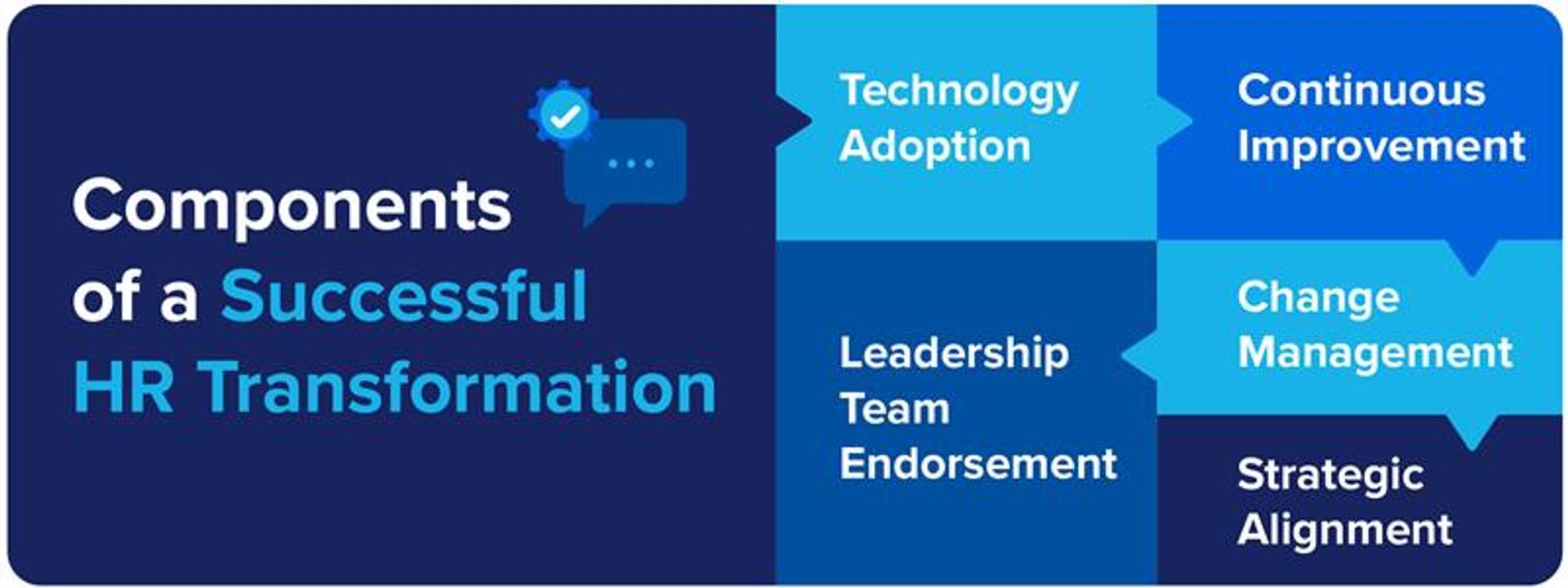HR transformation: Aligning people, processes, and purpose
HR transformation is rapidly becoming a boardroom priority, and with good reason. As organisations confront challenges like talent shortages, hybrid work models, and growing demands for exceptional employee experiences, rethinking the role and the operations of HR has never been more urgent. This shift marks a turning point, transforming HR from a support function into a central driver of organisational strategy and value. In this article, we explore how transformational HR and digital innovation are reshaping the workplace — and what your organisation can do to stay ahead.
Sonya Gillam

It’s not just about new tools, it’s about new expectations. Employees expect seamless digital HR experiences, while leadership seeks actionable insights to shape long-term strategy. The need for agile, scalable systems is pressing, and HR transformation provides the framework to deliver on both fronts.
What does HR transformation mean?
HR transformation is the strategic redesign of HR functions, capabilities, and processes to better support business outcomes. At its heart, it involves rethinking structures, technologies, and mindsets to align people strategy with organisational goals.
This forward-looking initiative includes digitalising core functions, workforce analytics, and a renewed focus on employee experience.
It replaces outdated systems and processes shaped by a silo mentality with agile, data-driven approaches that elevate HR from an administrative function to a strategic powerhouse.
It goes beyond automation. True transformation means fostering a culture of continuous improvement, empowering decision-making through real-time insights, and creating digital-first experiences that support and engage employees across the entire lifecycle.
Tools like AI-powered analytics, cloud-based platforms, and intelligent automation have become essential. But without the right mindset and cultural shift, technology alone won’t deliver the results.
This is where transformational HR makes its mark — focusing not only on operational efficiency, but on delivering long-term impact. When done well, it improves talent acquisition and retention, boosts agility, and strengthens the organisation’s ability to adapt and grow.
Components of a successful HR transformation
A successful HR transformation hinges on several key components. Each one is essential for making sure the initiative has a lasting, positive impact on the organisation. These are the essential building blocks:

Leadership buy-in
Leadership commitment is the bedrock of any successful HR transformation. When senior leaders visibly support the initiative, align it with the broader business strategy, and clearly communicate its purpose, it helps build the support and resources needed for success.
This leadership buy-in ensures that the transformation is prioritised, with a clear vision guiding every step of the process. Without this level of commitment, transformation efforts risk losing focus or stalling altogether.
Strategic alignment
For HR transformation to be effective, it must evolve in tandem with broader business objectives. This means developing a clear vision that ties HR initiatives directly to organisational goals, growth strategies, and the overall business direction. When integrated into the wider business plan, HR strategies become instrumental in driving performance.

Technology adoption
Digital transformation in HR is not just about adopting the latest tools, but about selecting the right technology. Cloud-based HR platforms, AI-driven analytics, mobile-enabled services, and automation tools are essential for improving efficiency and insight. These technologies allow HR to move from reactive to proactive, from administrative to strategic.
Change management
No transformation is complete without effective change management. It ensures that the transformation is adopted across all levels of the organisation — not just senior leadership but also managers, teams, and individual employees.
A clear change management strategy involves stakeholder engagement, clear communication, training programmes, and feedback mechanisms. When managed well, change is seen as a shared journey, not a top-down mandate.
Continuous improvement
HR transformation is not a one-off project, it’s a continuous journey. It requires ongoing evaluation, feedback loops, and agility to adapt to changing business needs. Embedding a culture of continuous improvement enables sustained impact and relevance.
Transformation in HR: From vision to execution
Transforming HR is no longer a question of if, but how. From aligning people strategy with business goals to adopting future-ready tools, successful HR transformation blends vision with execution.
The following sections explore proven practices, enabling technologies, and real-world success stories to guide your transformation journey.
Best practices for a future-proof HR transformation
A successful HR transformation balances strategic foresight with practical execution. Whether you're just starting out or optimising an existing programme, the following best practices can help you build a transformation that’s resilient, scalable, and people-focused.
| Best practice | Why it matters |
|---|---|
| Assess current HR capabilities | The journey begins with a comprehensive review of existing HR systems, processes, and competencies. This helps establish a baseline and identify gaps that must be addressed to meet both present and future workforce needs. |
| Create a phased transformation roadmap | Developing a structured, step-by-step roadmap allows the transformation to be implemented in manageable stages. By balancing short-term wins—like automating manual tasks or improving employee self-service—with longer-term goals, such as predictive workforce planning,organisations can maintain momentum without losing strategic focus. |
| Prioritise flexibility and scalability | HR tools and processes should be both adaptable and scalable. Investing in flexible solutions and designing workflows that can evolve with theocratisation ensures resilience in the face of change. Seamless integration with wider business systems also supports ongoing innovation and reduces the risk of becoming outdated. |
| Embed data governance and compliance | Data is central to digital transformation in HR. Strong governance ensures data is accurate, secure, and ethically used. Establishing clear policies also supports compliance with regulations such as GDPR, helping to build trust and minimise risk. |
| Design around the employee experience | A successful HR transformation puts people at the centre. This means designing user-friendly interfaces, incorporating employee feedback, and ensuring digital tools enhance daily work rather than disrupt it. A positive employee experience boosts adoption and drives long-term engagement. Prioritising employee well-being is not just a moral imperative, but also a strategic one. The World Health Organization reports that every dollar invested in mental health generates a fourfold return in increased productivity and improved health outcomes, highlighting the importance of well-being initiatives within HR transformation efforts. |
| Drive cultural and behavioural change | Transformation isn’t just about systems — it requires a shift in mindset. Engaging stakeholders early, building change leadership, and embedding new behaviours across the organisation are essential steps in creating a culture that embraces innovation and continuous improvement. |
Common pitfalls to avoid:
Even the most well-intentioned HR transformation initiatives can falter if key risks are overlooked. Avoiding these common missteps will help ensure smoother implementation and lasting success:
- Failing to involve key stakeholders early on: Transformation must be co-owned across functions. Early engagement secures buy-in, reduces resistance, and ensures alignment from day one.
- Underestimating the complexity of legacy systems: Outdated platforms often hide deep dependencies. Thorough audits and change impact assessments are essential before replacing or upgrading systems.
- Prioritising technology over people and processes: Tools are only as effective as the processes they support. A successful HR transformation balances digital solutions with human needs and strategic intent.
- Overlooking compliance and data security requirements: As HR becomes increasingly digital, protecting employee data and staying compliant with regulations (like GDPR) must be built into every step of the transformation.

Essential tools and services shaping digital HR transformation
The strategic value of HR digital transformation has never been clearer. As organisations face constant change, digital tools and data-driven insights enable HR to operate with speed, precision, and impact.
Research from the Academy to Innovate HR (AIHR) reveals a 27% increase in organisations acknowledging digital transformation in HR as a top priority in their people strategy — reflecting the growing recognition of technology's role in effective HR management.
The right tools and services are crucial to realising the full potential of digital transformation. Zalaris offers integrated solutions that support every stage of the transformation journey — from core systems modernisation to strategic workforce insights:
- Zalaris PeopleHub: An integrated platform for HR, payroll, time, and talent management, accessible across geographies. It streamlines operations and provides a consistent employee experience, supporting transformation at scale.
- SAP SuccessFactors implementation: Zalaris provides full lifecycle support for SAP-based HR systems—from design to deployment and ongoing optimisation. This enables organisations to modernise core HR capabilities while aligning with global best practices.
- Multi-Process HR Outsourcing (MPHRO): By managing HR services such as payroll, time, and benefits, Zalaris frees up internal teams to focus on strategic priorities — accelerating the pace of HR transformation.
- HR Analytics and Reporting: Actionable insights empower data-driven decisions. Zalaris equips HR leaders with powerful reporting tools to measure the impact of transformation and inform continuous improvement.
- Employee Self-Service Portals: These user-friendly tools reduce administrative workload, improve transparency, and enhance employee autonomy — all key enablers of a digital-first HR experience.
HR transformation in action: Marston’s PLC transforms HR and payroll with Zalaris
Marston’s PLC, a leading UK-based pub and brewing company, partnered with Zalaris to modernise its HR and payroll operations. The goal was to migrate from multiple legacy systems to a unified platform, Zalaris PeopleHub, in order to streamline processes, increase efficiency, and better support business growth.
The Challenges
Marston’s faced significant challenges with managing four separate payroll systems, particularly for diverse employee groups such as hourly paid staff and pensioners. The company struggled with inefficiencies, data silos, and the manual handling of approximately 140,000 time records and 1,500 new hires or rehires monthly.
The solutions implemented
Zalaris deployed PeopleHub, an integrated platform that brought payroll and HR functionalities together in a single system. The implementation allowed Marston’s to:
- Migrate from outdated systems to a centralised digital solution.
- Automate payroll processes, achieving near 100% automation.
- Introduce the ‘Pay on Demand’ feature, allowing employees to access earned wages before payday.
- Eliminate reliance on an in-house data centre and outdated SAP licences.
The outcomes
The results were transformative:
- Increased efficiency: Payroll automation reduced manual work and processing time, enabling HR to focus on strategic initiatives.
- Cost savings: The consolidation of systems and reduction in administrative overheads resulted in significant cost savings, including reduced printing and postage costs.
- Enhanced employee experience: HR teams and employees benefitted from a more intuitive, centralised system, improving user experience and transparency.
- Scalability: Marston’s future-proofed their HR infrastructure, supporting growth and aligning with the company’s long-term strategic goals.
Conclusion: Turning HR transformation into lasting impact
HR transformation is no longer a future aspiration — it’s a strategic imperative that reshapes how or organisations aim to remain agile, competitive, and people-centric. By aligning strategy, tools, and culture, HR can drive meaningful outcomes and become a catalyst for innovation and growth.
Whether your organisation is at the beginning of the transformation or ready to scale, success depends on choosing the right partners and making deliberate, informed decisions. We support every step of this journey, from digital platform implementation to long-term process optimisation, helping you turn your HR transformation into measurable impact.
Start today and build a more connected, responsive, and future-ready HR function by getting in touch with our expert team.

Sonya Gillam
Marketing Specialist, UK & Ireland
Sonya is a dedicated Marketing Specialist at Zalaris UK & Ireland. With extensive experience across various roles, from store management to Head Office operations, Sonya brings a wealth of knowledge in sales and marketing management to the team.
Table of Contents
- What does HR transformation mean?
- Components of a successful HR transformation
- Transformation in HR: From vision to execution
- Best practices for a future-proof HR transformation
- Common pitfalls to avoid:
- Essential tools and services shaping digital HR transformation
- Conclusion: Turning HR transformation into lasting impact